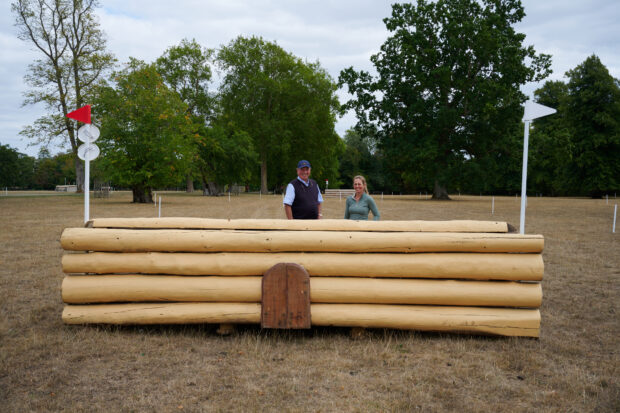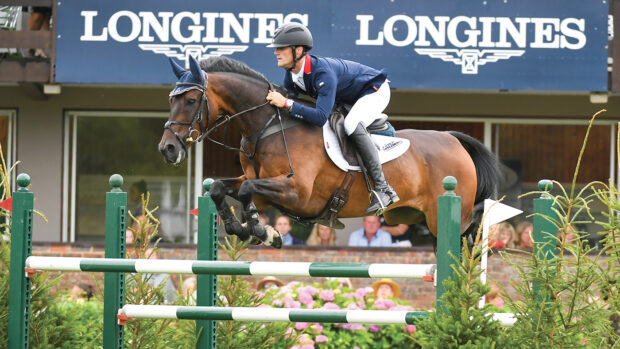Event riders competing at the Paris Olympics will be riding an Olympic eventing dressage test that was first introduced at the Tokyo Olympics in 2021.
The shortened dressage test, which lasts just under 4mins, was designed to make the phase more spectator-friendly with movements coming up more quickly. This means it is more intense for both horse and rider.
With fewer movements and less time to reorganise between them, it will be harder to score top marks and there are fewer opportunities to demonstrate the horse’s talent and training to the judges. The test includes movements not previously seen in eventing dressage including the canter zig-zag (canter half-pass in one direction, flying change, then canter half pass in the other direction, and a flying change) and walk to counter canter.
Olympic eventing dressage test: a judge’s perspective
Top international dressage judge Stephen Clarke, says the Olympic eventing dressage test is “very difficult, with no let-ups”.
“The counter canter strike off, which is quickly followed by two flying changes on a straight line across the diagonal is particularly challenging,” says Stephen. “If combinations make a mistake in that movement, it will be very hard for them to recover.”
Stephen was on hand at Royal Windsor Horse Show when the British squad ran through the test in public for the first time ahead of flying to Tokyo in 2021.
“It takes a very well-trained horse to do it well – those who have performed the test proved that if a horse isn’t on its rider’s aids, they will lose marks – there is no room for error,” says Stephen.
A rider’s thoughts on the new Olympic eventing dressage test
Five-star event rider and British eventing team regular, Kitty King, who was shortlisted for these Games and has ridden through the test in training, says: “It’s a very fast and furious test in that everything comes up very, very quickly. There’s the same amount of movements as a normal five-star test, but squeezed into a lot less time.
“If you make one mistake, it’s really hard to recover, and I think the trickiest thing is that horses and riders don’t have the time to recover from a mistake before the next movement comes up.”
On the canter half-pass zig-zag, Kitty says: “You have to be very prepared – you want to finish the half-pass a little early so you have a couple of straight strides through your change. Then you need to get back across in time to have your horse straight and get your other change in before you run out of room at the end of the arena.
“You have to be incredibly accurate to give the horse time, rather than rushing across in one direction and then flying back the other way. It’s trying to make it feel like you’ve got time to prepare the horse and to do good straight changes and then get into the half-pass nicely.”
Kitty also highlighted the walk to counter canter as being a challenge.
“Going from walk straight into counter-canter is not a difficult movement, but the event horses normally walk and pick up true canter, and so it would be easy for horses to anticipate what they normally do,” she says. “As a rider you have to be very clear with your aids and what you’re actually asking so the horse doesn’t second guess you. It’s much more like a pure dressage test.
“Also the first centre line requires you to go from canter to trot, whereas horses at this level are used to going from canter to halt, so through trying too hard, they might drop behind their riders. I trained my horses in this new movement so that they didn’t try to anticipate the halt.”
- Find out how to watch the Olympic eventing competition
What are the test movements and how is it marked?
The dressage phase of the Olympic eventing competition is taking place on one day in Paris, with all 65 competitors taking part in the first phase on Saturday 27 July. All riders complete a predetermined test of movements (see below) in front of three judges. The judges award marks out of 10 for each movement and, after combining the scores to give an overall percentage score, this is converted into penalty points (the higher the percentage, the lower the penalty score).
Here’s a full run down of the new Olympic eventing dressage test and what the judges are looking for…
Movement 1:
A: Enter collected canter
X: Collected trot
C: Track right
Judges looking for: Quality of trot and canter, transition to collected trot, balance in turn
Movement 2:
M-X-K: Extended trot
K: Collected trot
Judges looking for: Extension and regularity of steps, elasticity, balance and lengthening of frame
Movement 3:
Transitions at M and K
Judges looking for: Rhythm, engagement of hind legs into extended trot and return to collected trot. Clarity of transitions
Movement 4:
After A: Turn down quarter line, shoulder in left
Judges looking for: Regularity and quality of trot, collection and balance, flexion, bend and angle
Movement 5:
At B-E line: Half-pass left at H
Judges looking for: Regularity and quality of trot, collection and balance, flexion, bend, fluency, crossing of legs
Movement 6:
C: Halt
Judges looking for: Transition, engagement and immobility
Movement 7:
C: Rein-back five steps, proceed collected trot
Judges looking for: Accuracy, regularity of steps, straightness, balance and acceptance of contact in the reinback
Movement 8:
M-Far quarter line: Half-pass right
Judges looking for: Regularity and quality of trot, collection and balance, flexion, bend, fluency, crossing of legs
Movement 9:
At quarter line between B&E: Shoulder-in right to end, then track left
Judges looking for: Regularity and quality of trot, collection and balance, flexion, bend and angle
Movement 10:
P-S: Extended walk
Judges looking for: Regularity, lengthening of steps and outline, acceptance of contact, freedom of shoulders, over-track
Movement 11:
S-M-C: Medium walk
Judges looking for: Regularity of steps, rhythm, over-track, and acceptance of contact
Movement 12:
C: Collected canter right lead
Judges looking for: Transition to collected canter. Quality of canter and straightness
Movement 13:
H-X: Flying change on quarter line
Judges looking for: Precise execution, correctness of flying change, straightness, uphill tendency & expression
Movement 14:
X-F: Flying change on the quarter line
Judges looking for: Precise execution, correctness of flying change, straightness, uphill tendency & expression
Movement 15:
After A: Turn down quarter line, half-pass right quarter line to quarter line
Judges looking for: Regularity and quality of canter, collection and balance, flexion, bend, fluency, crossing of legs
Movement 16:
Flying change on the quarter line
Judges looking for: Precise execution. Flying change on the aids, straightness, uphill tendency and expression
Movement 17:
Between B&E: Half-pass left quarter line to quarter line
Judges looking for: Regularity and quality of canter, collection and balance, flexion, bend, fluency, crossing of legs
Movement 18:
Flying change on quarter line to end, then track right
Judges looking for: Precise execution. Flying change on the aids, straightness, uphill tendency and expression
Movement 19:
M-F: Extended canter
F: Collected canter
Judges looking for: Rhythm, length of stride and frame. Straightness. Transitions
Movement 20:
A: Down centre line
L: Halt, salute
Judges looking for: Quality of canter and straightness on center line. Transition to halt and immobility
Collective Mark: Harmony of athlete and horse
Judges looking for: A confident partnership created by adhering to the scale of training
- To stay up-to-date with all the breaking news throughout the Olympic Games, Royal International Horse Show and more, subscribe to the Horse & Hound website
You might also enjoy this…

Who will be commentating on the equestrian sports at the Paris Olympics?

49 nations represented as definite entries for Paris Olympic equestrian events revealed

Subscribe to Horse & Hound magazine today – and enjoy unlimited website access all year round
Stay in touch with all the news in the run-up to and throughout the Paris Olympics, Royal International, Burghley and more with a Horse & Hound subscription. Subscribe today for all you need to know ahead of these major events, plus online reports on the action as it happens from our expert team of reporters and in-depth analysis in our special commemorative magazines. Have a subscription already? Set up your unlimited website access now




